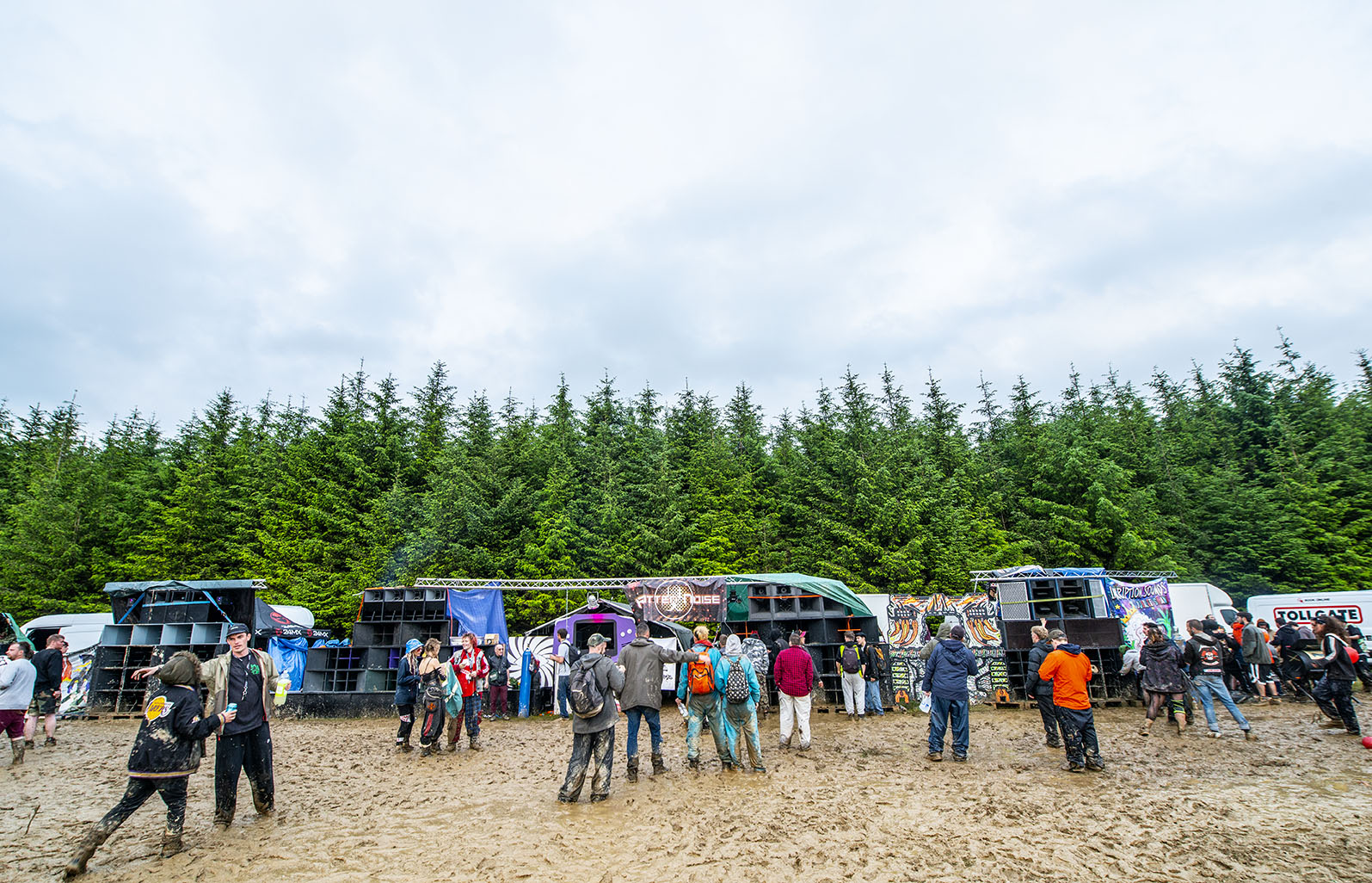News sites hummed and social media timelines blazed earlier this month, as thousands descended on a disused airfield in Cornwall for a free party in the English rain on the 3rd of June onwards.
“Thousands attend four-day illegal rave on Cornwall moorland,” one headline from The Independent read. “Roads chaos as hundreds flock to illegal rave in Cornwall,” read another, via the BBC. While news sources claim the party lasted multiple nights, attendees say it was more like two. Either way, it occurred on the 30th anniversary of Castlemorton, the 30,000-person gathering that fractured the bones of alternative British culture.
Videos by VICE
After Castlemorton came a deluge of tabloid fervour that resulted in the hastily put together Criminal Justice Bill, which banned unlicensed gatherings of more than 20 people playing “repetitive beats”. 30 years on, everything and nothing has changed. We may have iPhones and air-fryers but the Tories have ruled for over a decade, and – with this year’s Police, Crime, Sentencing and Courts Act – still pass bills that skewer vital rights.
Sounds like perfect ingredients for a law-defying rave, then? Here’s the inside story on how the UK’s biggest free party for 20 years came to be.
THE PRE-PARTY PLANNING
“Ultimately we’re looking at much the same criteria you’d look for in a legal event site,” I’m told over email by a person we’ll call Organiser A.
The selected site – just outside the 3,000ish population town of Camelford – is not alien to a free party. Nearby Bodmin Moor hosted the 14-night (14!) White Goddess festival in 1991, while Davidstow Moor itself was home to a 2,500-person UK Tek in 2006. (Tek is a loose Europe-wide community of travellers that evolved when Spiral Tribe – the socialist soundsystem targeted by police following Castlemorton – moved to Paris after the Criminal Justice Bill passed in 1994. There are annual Tek events all over Europe: this party was one of them.)
Despite the fact we live and breathe via social media now, methods of alerting attendees have remained broadly old school. Things stay offline. Those in the know receive a text the week before, containing a “save the date” but no location details. Three phone lines – for different UK areas – opened after 2PM on the Friday.
“We rang the magical phone number and off we went,” says Kassara Parkes, 19, from Somerset. She attended with three friends. “It was decent getting up there as we convoyed most of the way.”
Much of the estimated 500-vehicle convoy had congregated in a carpark in a neighbouring county. Before long, the site – consisting of at least 35 rigs and described by Organiser A as “the biggest UK free party, at least in terms of numbers of soundsystems, in 15 to 20 years” – was a blitz of sound, honouring the magic number’s final instruction for those arriving: “LET’S MAKE SOME NOIZE.”
THE ACTUAL PARTY ITSELF


Heavy grey rainclouds may have been gathering in distant skies, but the party popped off from Friday evening onwards. Most attendees were around 18 to 30-years-old, plus a clutch of old school ravers, families and the odd dog. Attendance estimates vary somewhat wildly, from 1,000 to 10,000. Most educated guesses put it somewhere in between, before rainfall around sunrise turned much of the site into a bog and sent some of the less hardy home.
Robin Wealleans, a free party attendee since the 90s, says: “There was a sense of defiance in the air: against the Jubilee and of the lies told by the government during Partygate. If they can party illegally, why shouldn’t we?”
So how was it for the neighbours? Mark Luxton lives in Delabole, around five miles (“as the crow flies”) from Davidstow and says that “outdoors you could hear the beat” but “by no sense could you hear vibrations…”
Kassara Parkes says that it was a safe space: “I always feel very safe at free parties, even the big ones. The people that make it there are genuinely nice people that just want to have a mix and a boogie until the sun comes up. There’s a big sense of community that you don’t get with legal festivals.”
This sense of security could also be partly down to the lack of a criminal element selling narcotics – unlike some of those that dogged 90s raves. “There aren’t any gangsters anymore, which means no door tax or being forced to buy supplies from unscrupulous characters,” Robin adds. “These days people mostly bring their own drugs, and they also seem more clued-up now.”
THE POLICE PRESENCE

“I find it’s a complete lucky dip with how the authorities act,” says a major south-west soundsystem, who preferred not to give their name. Nevertheless they tell me that the police – who made ten arrests – were broadly amenable. Robin concurs: “They were very good natured and pragmatic overall. I even overheard a cop advise one lad to ‘wipe that coke off your nose!’”
Multiple sources, however, pointed out one commonly made misstep by the police: roadblocks. Police were first called around 10PM Friday and, after entry to the site was blocked off, attendees were forced to abandon their vehicles on lanes and traipse across farmland to the site. “The attempt to block entrances is never logical,” says the south-west soundsystem. “People aren’t going to turn around after travelling, sometimes across the country.”

According to photographer Matthew Smith, author of Exist to Resist and Full On. Non-Stop. All Over., blocking entrances has multiple motives. “It meant that [ravers] didn’t have resources – warmth, shelter, clothes. The things that give them quality of life. This is a stupid decision, but it’s also calculated because it maximises disruption to local community which can then used for PR.”
PRESS, RUMOURS AND RUBBISH
“The reason I began documenting this culture was that the media were telling lies about it,” Smith says. And it didn’t take long for the mills of the press to turn. On Saturday, stories abounded in local and national publications – Daily Mail nailed the inevitable blocked roads splash, while social media cabals on local Facebook groups frothed at the mouth with rage. They had some support, but mood mostly ranged from the understandably vexed (“This racket is still going!”) to the downright murderous (“Totally worthless dregs of society with no respect or care for other species. Need wiping off the face of the earth”).
As the weekend wore on, attention turned to the event’s environmental impact. A GoFundMe – which has now accrued over £2,000 – was started by ravers to provide skips for the rubbish. A hardcore group of around 50 stayed to clean up. One local, who didn’t want to be named, told me: “They did a fantastic job cleaning up. The people I met on Monday who stayed behind to help were very friendly, and said they wouldn’t leave until the last bit was cleaned up.”
I contacted Forestry England, who control the land. They refused the GoFundMe cash as the event was illegal. Still, they said that, “the rubbish was collected by the attendees and piled inside the main forestry gate, for which they did a good job.”
However, they confirmed stories that the forest surrounding the airstrip would be shut. A Forestry England Spokesperson said this would be for eight weeks to “allow the human waste to biodegrade. There is [also] other hazardous waste such as used tissues, sanitary products and drug equipment.” They also said “a rave at this time of the year will likely have had a substantial impact on numerous nesting birds.”

Aaran, who led the cleanup, tells me over email there would have been far less rubbish if there hadn’t been roadblocks as many ravers were up to two miles away from their vehicles. He also lays blame at the feet of the British legislature: “In other countries, where it’s possible to do these events legally, the cost is covered by donations on the gate and the waste is removed in vehicles.”
PARTY ON?
“Our generation is going through one of the most repressive times in modern history… Communities are often crushed and people feel like they are alone and have nothing to aim for,” I am told by the south-west soundsystem. “For that one or two days of the free party, people’s worries are forgotten and they are surrounded by friends and like minded individuals which rebuilds that sense of community.”
This newly disenfranchised generation are going through similar experiences that dogged their restless, raver forebears. They’re ruled by a government they loathe and that, judging by the passing of bills that infringe their right to live and protest freely, doesn’t think much of them. But the new crowd has the benefit of time, technology and inherited rage. So can these parties be part of something bigger?
“We want to do more than provide a temporary sanctuary,” wrote the soundsystem redtekuk on their Instagram afterwards. “We want to channel this energy into the fight for something better, to kill this sick system itself, not hide from its symptoms.”
Get some portaloos sorted – ideally chuck in a welfare tent too – and what could there possibly be to lose?







